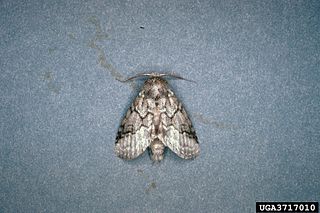
The Southwestern United States, also known as the American Southwest or simply the Southwest, is a geographic and cultural region of the United States that includes Arizona and New Mexico, along with adjacent portions of California, Colorado, Nevada, Oklahoma, Texas, and Utah. The largest cities by metropolitan area are Phoenix, Las Vegas, El Paso, Albuquerque, and Tucson. Before 1848, in the historical region of Santa Fe de Nuevo México as well as parts of Alta California and Coahuila y Tejas, settlement was almost non-existent outside of Nuevo México's Pueblos and Spanish or Mexican municipalities. Much of the area had been a part of New Spain and Mexico until the United States acquired the area through the Treaty of Guadalupe Hidalgo in 1848 and the smaller Gadsden Purchase in 1854.

The North American Central Time Zone (CT) is a time zone in parts of Canada, the United States, Mexico, Central America and some Caribbean islands.

Notodontidae is a family of moths with approximately 3,800 known species. The family was described by James Francis Stephens in 1829. Moths of this family are found in all parts of the world, but they are most concentrated in tropical areas, especially in the New World.

Dissorophidae is an extinct family of medium-sized temnospondyls that flourished during the late Carboniferous and early Permian periods. The clade is known almost exclusively from North America.

The spotted chorus frog or Clark's tree frog is a small, nocturnal chorus frog native to the grasslands and prairies of the central United States and Tamaulipas, Mexico.

The small-mouth salamander is a species of mole salamander found in the central United States, from the Great Lakes region in Michigan to Nebraska, south to Texas, and east to Tennessee, with a population in Canada, in Pelee, Ontario. It is sometimes referred to as the Texas salamander, porphyry salamander, or the narrow-mouthed salamander. The Kelley's Island salamander was synonymized with A. texanum in 1995.

The white-ankled mouse is a species of rodent in the family Cricetidae. It is found in Mexico and in New Mexico, Oklahoma and Texas in the United States.
Elasmias is a genus of tropical tree-living air-breathing land snails, arboreal pulmonate gastropod mollusks in the family Achatinellidae.

The American hog-nosed skunk is a species of hog-nosed skunk from Central and North America, and is one of the largest skunks in the world, growing to lengths of up to 2.7 feet (82 cm). Recent work has concluded the western hog-nosed skunk is the same species, and Conepatus leuconotus is the correct name of the merged populations.

The Aphonopelma hentzi, also known as Texas brown tarantula, Oklahoma brown tarantula, or Missouri tarantula, is one of the most common species of tarantula living in the Southern United States today. Texas brown tarantulas can grow to leg spans in excess of 10 cm (4 in), and weigh more than 85 g (3 oz) as adults. Their bodies are dark brown, though shades may vary between individual tarantulas. The colors are more distinct after a molt, as with many arthropods.

Hippia is a genus of moths of the family Notodontidae described by Heinrich Benno Möschler in 1878.

Lochmaeus bilineata, the double-lined prominent moth, is a moth of the family Notodontidae. It is found in the eastern two-thirds of the United States and southern Canada, west to New Mexico in the south and Saskatchewan in the north.

Cecrita guttivitta, the saddled prominent moth, is a species of moth of the family Notodontidae. It is found in North America, including Alabama, Arkansas, Connecticut, Delaware, Florida, Georgia, Illinois, Indiana, Iowa, Kansas, Kentucky, Maine, Maryland, Massachusetts, Minnesota, New Brunswick, New Hampshire, New Jersey, New York, North Carolina, Ohio, Oklahoma, Ontario, Pennsylvania, South Carolina, Tennessee, Vermont, Virginia, West Virginia and Wisconsin.

Elasmia is a genus of moths of the family Notodontidae.

Elasmia mandela is a species of moth of the family Notodontidae first described by Herbert Druce in 1887. It occurs in Mexico, Costa Rica, and the US states of Texas and Oklahoma.

Elasmia cave is a species of moth of the family Notodontidae. It occurs in New Mexico, Texas and possibly Mexico. Adults are on wing from April to early October.
Elasmia insularis is a species of moth of the family Notodontidae. It is found in Cuba. It has been recorded from Texas, but these are probably misidentifications and the species is not thought to be present in the United States.
Nystaleinae is a subfamily of the moth family Notodontidae. The subfamily was described by William Trowbridge Merrifield Forbes in 1948.

Nystalea indiana, commonly known as Grote's tropical prominent moth, is a species of prominent moth in the family Notodontidae. It was described by Augustus Radcliffe Grote in 1884 and is found in North America.
Dasylophia thyatiroides, the gray-patched prominent, is a species of prominent moth in the family Notodontidae. It was described by Francis Walker in 1862 and is found in North America.















